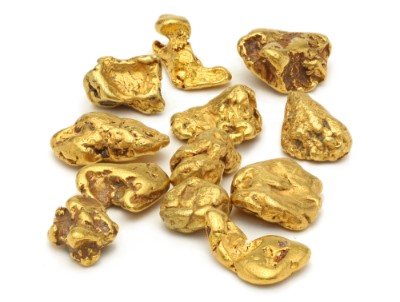Geology of Gold
Learn interesting geological facts about gold - where to find it, top producers, and why to invest
| Physical Properties of Gold | |
|---|---|
 | |
| Composition | Gold, with small amounts of silver; sometimes also copper and iron |
| Chemical Classification | Native Element |
| Chemical Composition | Au |
| Atomic Number | 79 |
| Color | Golden yellow to brass yellow |
| Streak | Gold yellow |
| Luster | Metallic |
| Hardness | 2.5 to 3 |
| Specific Gravity | 19.3 |
| Fracture | Hackly |
| Rock Type | Sedimentary, Metamorphic |
| Crystal System | Isometric |
| Modern Uses | Jewelry, electronics, medicine, space, awards, investment |
Whether you have a general fascination with all aspects of geology or you are seeking specific information about the gold market, it is important to apply due diligence so that you know as much as possible about this precious metal and understand the power of gold as an investment.
How powerful?
Gold has backed up currencies throughout history and has never lost prestige or universal appeal. Speak the language of gold and you will be understood and welcomed in nearly every society around the globe.
Continue reading to learn geological facts about this precious metal and why you should consider investing.
How to Identify Real Gold
Identifying authentic gold ore is easier said than done. Even early prospectors often suffered a learning curve trying to differentiate gold ore from other copycat minerals like silica, mica, and pyrite. To identify real gold, you can start by spotting rock with distinct copper tones, particularly if the geographic area of your search has yielded previous gold finds.
If you happen upon a big shiny chunk of yellow rock, it may be fool’s gold (iron pyrite), which is a relatively worthless lookalike mineral that triggered many short, temporary celebrations among hopeful gold-seekers in the past. It is easy to be confused because so many minerals are gold-colored as a direct result of the volcanic activity that created all types of ore.
Typically, gold is found in large veins, the result of cooled, cemented lava activity that was further abraded by the force of rivers and streams. Another clue to a true gold find is an absence of “cleavage,” a characteristic sought by geologists when they differentiate gold deposits from other minerals.
Where to Find Gold in the US
US Geological Survey scientists believe that there are still 52,000 tons of gold in the ground, and this estimate is on the conservative side. Their in-depth surveys pinpoint select gold regions where a prospector’s chances of finding gold are most likely.
The American Mining Rights Association (AMRA) also keeps tabs on gold hot spots. While the amount of romantic lore associated with the California Gold Rush 100+ years ago remains, this state is no longer the gold capital of the US. That honor is now shared between Utah, Colorado, South Dakota, and Washington State. Nevada is also named a top-6 US gold prospecting area.
Top Gold-Producing Countries
According to Mining Technology, China not only produces the most gold, but the nation is also the leading consumer of the precious metal. Just behind China, in terms of gold production, is neighboring Australia.
The US is listed as number three on this list and Russia ranks fourth in international gold extraction volume, followed by South Africa and Peru. South Africa, once the world’s largest gold-producing nation and home to the world’s deepest mines, is no longer among the top six producers. Strikes by miners have dramatically impacted production. In fact, the African nation of Ghana could soon catch up with or surpass South Africa.
Rounding out the top of the list are Canada, Indonesia, and Uzbekistan (though it is important to note that Indonesia’s ranking has been seriously impacted by the nation’s illegal mining practices in concert with political unrest).
How Much Above-Ground Gold is in Circulation?
US billionaire Warren Buffett reportedly theorized to BBC News that the total amount of above-ground gold in the world “could fit into a cube with sides of just 20m (67 feet).” But not everyone concurs with Buffett’s assessment, least of all gold historian Timothy Green, whose estimate is in line with Gold Money founder James Turk. These experts believe a more accurate assessment of above-ground gold is at least 155 tons.
The question of how much gold is in circulation will continue to drive imaginations and prompt more estimates, but if you are interested in dollar value, consider the Thompson Reuters GFMS assessment of around $950 billion.
The Future of Gold
Over the centuries, gold has been prized for its decorative beauty, malleability, and value, but this precious metal is also playing a big role in today’s technological advancements and it is likely to continue doing so well into the future. Gold is considered essential for connecting wires, strips, relays, joints, and switches because it doesn’t corrode or tarnish and you can also find gold used in the manufacturing of televisions and other appliances that depend upon smooth conductivity to keep them operational.
But don’t think you can retire on the collective amount of gold used to fabricate all of your devices. According to Geology.com, there is only about 50-cents worth of gold in your cell phone. If you would like to get serious about securing your financial portfolio through precious metals, consider buying gold bullion.





